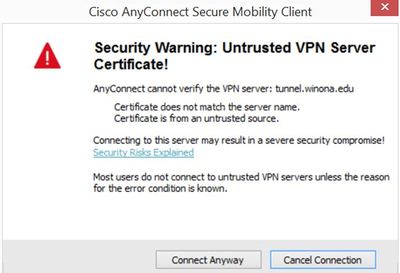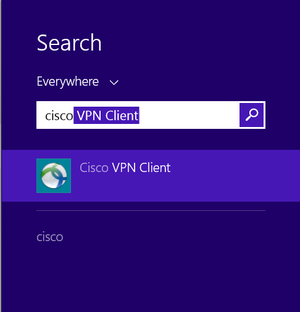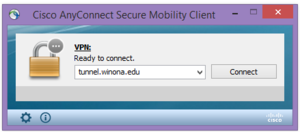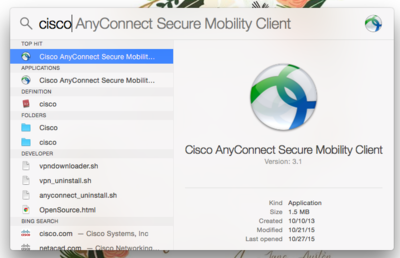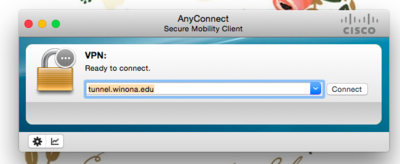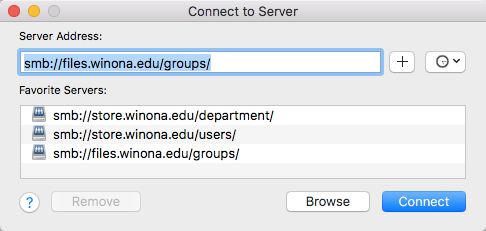Difference between revisions of "VPN"
| (17 intermediate revisions by 4 users not shown) | |||
| Line 9: | Line 9: | ||
*KeyServer applications (e.g., [[Adobe Photoshop]], [[Adobe Acrobat]]) These applications will require VPN to run off campus. | *KeyServer applications (e.g., [[Adobe Photoshop]], [[Adobe Acrobat]]) These applications will require VPN to run off campus. | ||
| − | |||
| − | |||
| − | |||
| − | |||
==Find the Cisco AnyConnect VPN software on Your WSU Laptop== | ==Find the Cisco AnyConnect VPN software on Your WSU Laptop== | ||
| Line 24: | Line 20: | ||
* Search for Cisco | * Search for Cisco | ||
* Select 'Cisco AnyConnect Secure Mobility Client' | * Select 'Cisco AnyConnect Secure Mobility Client' | ||
| − | * You will be prompted to Connect and login to WSU with your StarID | + | * You will be prompted to Connect and login to WSU with your StarID and password. |
===On a PC (Windows 8.1)=== | ===On a PC (Windows 8.1)=== | ||
| Line 33: | Line 29: | ||
* Choose Connect in the menu below: | * Choose Connect in the menu below: | ||
[[File:CiscoAnyConnect.png|300px]] | [[File:CiscoAnyConnect.png|300px]] | ||
| − | * Use your | + | * Use your StarID and password to login |
| − | |||
| − | |||
| − | |||
| − | |||
| − | |||
===On a Mac=== | ===On a Mac=== | ||
| Line 49: | Line 40: | ||
* Connect to Tunnel.winona.edu | * Connect to Tunnel.winona.edu | ||
[[File:VPN_Mac_Cisco_Connect.png|400px]] | [[File:VPN_Mac_Cisco_Connect.png|400px]] | ||
| − | * Use your | + | * Use your StarID and password when prompted to login |
| Line 56: | Line 47: | ||
=Map Network Drives= | =Map Network Drives= | ||
| − | == | + | == '''Mapping network storage for Employees''' == |
| + | |||
| + | '''Windows 10''' | ||
You will need to manually map your Personal Network Storage also referred to as R: drive. | You will need to manually map your Personal Network Storage also referred to as R: drive. | ||
* Open File Explorer from the Taskbar | * Open File Explorer from the Taskbar | ||
* Use the drop down arrow in the top menu for 'Map network drive' and select Map network drive | * Use the drop down arrow in the top menu for 'Map network drive' and select Map network drive | ||
| − | * Type the following in Folder: \\store\users\( | + | * Type the following in Folder: \\store\users\(your StarID) |
* Select 'Reconnect at sign-in' | * Select 'Reconnect at sign-in' | ||
* Finish | * Finish | ||
| + | |||
| + | '''Mac OS''' | ||
| + | * Use the Finder | ||
| + | * Go | ||
| + | * Connect to Server | ||
| + | * Server address for Employees to get to personal storage: smb://store.winona.edu/users/your StarID | ||
| + | * Server address for Employees to get to department drive: smb://store.winona.edu/department | ||
==Map Network Drives Continued (for after August 8th)== | ==Map Network Drives Continued (for after August 8th)== | ||
| Line 74: | Line 74: | ||
* Go to This PC to see the network drives mapped from the start menu (See Fig 1.) | * Go to This PC to see the network drives mapped from the start menu (See Fig 1.) | ||
| − | [[File: | + | [[File:ConnectToServer.png|frame|Fig 2. Typical list of network connections on a MacBook]] |
'''Mac''' | '''Mac''' | ||
| Line 86: | Line 86: | ||
*[[Local network storage]] | *[[Local network storage]] | ||
*[[PC laptop backup|Backing up your PC laptop]] | *[[PC laptop backup|Backing up your PC laptop]] | ||
| − | |||
| − | |||
[[Category:Definition]][[Category:Network]][[Category:PC]][[Category:Laptop Exchange]][[Category:Backup]][[Category:Update]] | [[Category:Definition]][[Category:Network]][[Category:PC]][[Category:Laptop Exchange]][[Category:Backup]][[Category:Update]] | ||
Revision as of 17:38, 4 January 2018
About this Article
VPN stands for Virtual Private Network. It is used to connect to the WSU network when you are off-campus. Students and Employees can use this software. Only WSU laptops can run this software.
Cisco AnyConnect VPN client
Using the Cisco AnyConnect VPN client software, you can connect a WSU laptop to the WSU network from off campus. This software is already installed on all WSU laptops. A VPN connection enables you to access select network resources as if you were on campus connected to our network directly. The data is encrypted to preserve security. This includes:
- Network storage drives (e.g., personal, class, departmental) Note: See instructions below to Map Network Drives
- KeyServer applications (e.g., Adobe Photoshop, Adobe Acrobat) These applications will require VPN to run off campus.
Find the Cisco AnyConnect VPN software on Your WSU Laptop
NOTE: You may see this error a couple times while trying to connect. Click on "Connect anyway".
On a PC (Windows 10)
- From the Windows Start Screen
- Use the Search icon
- Search for Cisco
- Select 'Cisco AnyConnect Secure Mobility Client'
- You will be prompted to Connect and login to WSU with your StarID and password.
On a PC (Windows 8.1)
- From the Windows Start Screen
- Search "Cisco"
- Select "Cisco VPN Client"
- Choose Connect in the menu below:
- Use your StarID and password to login
On a Mac
- Click on Spotlight in the upper right corner
- Type in "Cisco"
- Select "Cisco AnyConnect Secure Mobility Client"
- Connect to Tunnel.winona.edu
- Use your StarID and password when prompted to login
Map Network Drives
Mapping network storage for Employees
Windows 10
You will need to manually map your Personal Network Storage also referred to as R: drive.
- Open File Explorer from the Taskbar
- Use the drop down arrow in the top menu for 'Map network drive' and select Map network drive
- Type the following in Folder: \\store\users\(your StarID)
- Select 'Reconnect at sign-in'
- Finish
Mac OS
- Use the Finder
- Go
- Connect to Server
- Server address for Employees to get to personal storage: smb://store.winona.edu/users/your StarID
- Server address for Employees to get to department drive: smb://store.winona.edu/department
Map Network Drives Continued (for after August 8th)
If you want to connect to Personal Network or Department Network drives from off-campus, you will need to VPN and Map Network drives to access them.
Windows 8.1 & 10 PC
- Go to Start Screen and select the Tile Map Network Drive
- A script window will appear and your drives will be mapped
- Go to This PC to see the network drives mapped from the start menu (See Fig 1.)
Mac
- In Finder, hold down <CommandKey> then hit the <K> key to bring up "Connect to Server"
- Mac users connect to one of the network locations listed in the Fig 2.
